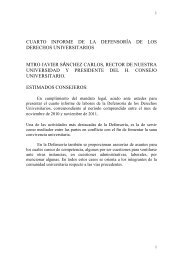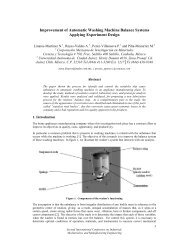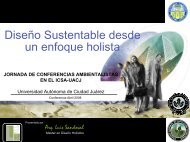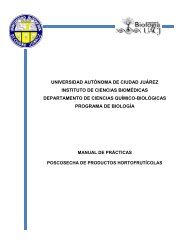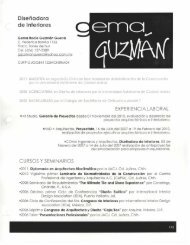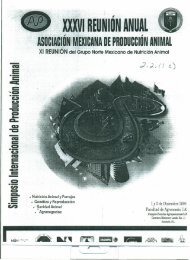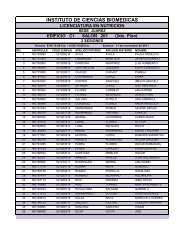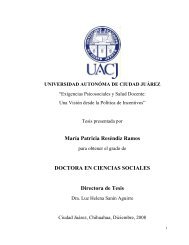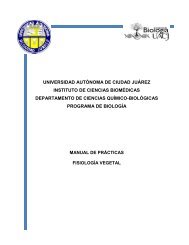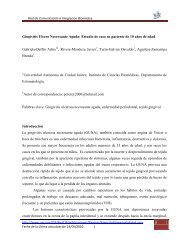journal of computers issn 1796-203x - Universidad Autónoma de ...
journal of computers issn 1796-203x - Universidad Autónoma de ...
journal of computers issn 1796-203x - Universidad Autónoma de ...
Create successful ePaper yourself
Turn your PDF publications into a flip-book with our unique Google optimized e-Paper software.
EDITORS<br />
Damminda Alahakoon, Monash University, Australia<br />
Henry Chen, Wright State University, USA<br />
Jiming Chen, Zhejiang University, China<br />
Xiaochun Cheng, Middlesex University, UK<br />
Monica Chis, "Avram Iancu" University, Romania<br />
Meledath Damodaran, Vienna University <strong>of</strong> Technology, Austria<br />
Matthias Dehmer, Vienna University <strong>of</strong> Technology, Austria<br />
Gi<strong>de</strong>on Dror, The Aca<strong>de</strong>mic College <strong>of</strong> Tel-Aviv-Yaffo, Isreal<br />
Dingzhu Du, University <strong>of</strong> Minnesota, USA<br />
ACM Fong, Auckland University <strong>of</strong> Technology, New Zealand<br />
Subramaniam Ganesan, Oakland University, USA<br />
José M. García, University <strong>of</strong> Murcia, Murcia, Spain<br />
Antonios Gasteratos, Democritus University <strong>of</strong> Thrace, Greece<br />
Phalguni Gupta, Indian Institute <strong>of</strong> Technology, India<br />
Song Han, Curtin University <strong>of</strong> Technology, Australia<br />
Ramzi A. Haraty, Lebanese American University, Lebanon<br />
Jiankun Hu, RMIT University, AUSTRALIA<br />
Sanjay Jasola, Wawasan Open University, Malaysia<br />
Julia Johnson, Laurentian university, Canada<br />
Dimitris Kanellopoulos, University <strong>of</strong> Patras, Greece<br />
Sotiris Kotsiantis, University <strong>of</strong> Patras, Greece<br />
Bjorn Gustaf Landfeldt, University <strong>of</strong> Sydney, Australia<br />
Soo-Young Lee, Auburn University, USA<br />
Daniel Lemire, University <strong>of</strong> Quebec at Montreal, Canada<br />
Kuan-Ching Li, Provi<strong>de</strong>nce University, Taiwan<br />
Yuan Liao, University <strong>of</strong> Kentucky, USA<br />
Guohui Lin, University <strong>of</strong> Alberta, Canada<br />
Anirban Mahanti, Indian Institute <strong>of</strong> Technology, India<br />
Tshilidzi Marwala, University <strong>of</strong> the Witwatersrand, South Africa<br />
Sabah Mohammed, Lakehead University, Canada<br />
Edward David Moreno, University <strong>of</strong> Amazonas State, Brazil<br />
Fulufhelo V. Nelwamondo, Harvard University, USA<br />
Mehmet Ali Orgun, Macquarie University, Australia<br />
Sandip Patel, Morgan State University, USA<br />
Lalit M. Patnaik, Indian Institute <strong>of</strong> Science, India<br />
Priyadarsan Patra, Intel Corp., USA<br />
Balwin<strong>de</strong>r Raj, Indian Institute <strong>of</strong> Technology Roorkee, India<br />
Jacob Savir, New Jersey Institute <strong>of</strong> Technology, USA<br />
Bhekisipho Twala, CSIR, South Africa<br />
Lizhe Wang, Rochester Institute <strong>of</strong> Technology, USA<br />
Wei Wang, Indiana University-Purdue University Indianapolis, USA<br />
Wai Lok Woo, Newcastle University, UK<br />
Jie Wu, Florida Atlantic University, USA<br />
Feng Xia, Queensland University <strong>of</strong> Technology, Australia<br />
Xin-She Yang, University <strong>of</strong> Cambridge, UK<br />
Lihua You, Bournemouth University, UK<br />
David Zhang, Hong Kong Polytechnic University, China<br />
Wei Zhao, Texas A&M University, USA<br />
Binhai Zhu, Montana State University, USA<br />
Qiang Zhu, The University <strong>of</strong> Michigan, USA<br />
JOURNAL OF<br />
COMPUTERS<br />
IISSN <strong>1796</strong>--203X<br />
Journal <strong>of</strong> Computers (JCP) is a scholarly peer-reviewed open-access international<br />
scientific <strong>journal</strong> launched in 2006, published for researchers, <strong>de</strong>velopers, technical managers,<br />
and educators in the computer field. It provi<strong>de</strong> a high pr<strong>of</strong>ile, leading edge forum for aca<strong>de</strong>mic<br />
researchers, industrial pr<strong>of</strong>essionals, engineers, consultants, managers, educators and policy<br />
makers working in the field to contribute and disseminate innovative new work on all the areas<br />
<strong>of</strong> <strong>computers</strong>. These areas inclu<strong>de</strong>, but are not limited to, the following:<br />
• Computer Organizations and Architectures<br />
• Operating Systems, S<strong>of</strong>tware Systems, and Communication Protocols<br />
• Real-time Systems, Embed<strong>de</strong>d Systems, and Distributed Systems<br />
• Digital Devices, Computer Components, and Interconnection Networks<br />
• Specification, Design, Prototyping, and Testing Methods and Tools<br />
• Artificial Intelligence, Algorithms, Computational Science<br />
• Performance, Fault Tolerance, Reliability, Security, and Testability<br />
• Case Studies and Experimental and Theoretical Evaluations<br />
• New and Important Applications and Trends<br />
JCP invite original, previously unpublished, research papers, review, survey and tutorial papers, application papers, plus case studies, short<br />
research notes and letters, on both applied and theoretical aspects.<br />
AUTHOR GUIDELINES available on the web site at: http://www.aca<strong>de</strong>mypublisher.com/forauthors.html<br />
Special Issues are an important component <strong>of</strong> JCP. JCP encourage recognized experts to create special issues that feature specifically aimed<br />
and targeted topics <strong>of</strong> high current interest falling within the scope <strong>of</strong> the Journal.<br />
JCP also invites organizers <strong>of</strong> high-quality conferences/workshops in the field to guest-edit Special Issue to guarantee fast publication <strong>of</strong><br />
exten<strong>de</strong>d versions <strong>of</strong> the high-quality conference/workshop papers in the Journal.<br />
SPECIAL ISSUE GUIDELINES available at: http://www.aca<strong>de</strong>mypublisher.com/specialissuegui<strong>de</strong>lines.html<br />
EDITOR-IN-CHIEF<br />
Pr<strong>of</strong>. Dr. Prabhat Mahanti,<br />
University <strong>of</strong> New Brunswick, Canada.<br />
E-mail: pmahanti@gmail.com<br />
Abstracting & In<strong>de</strong>xing<br />
• Biblio ST2I<br />
• Cabell - CS/BIS<br />
• CSA<br />
• DBLP<br />
• DOAJ - Computer Science<br />
• EBSCO - Aca<strong>de</strong>mic Search<br />
• EBSCO - Computers & Applied Sciences<br />
• EI Compen<strong>de</strong>x<br />
• Genamics JournalSeek<br />
• GetCITED<br />
• Google Scholar<br />
• INSPEC<br />
• Intute - Science Engineering & Technology<br />
• Journal Info<br />
• List <strong>of</strong> OA Journals<br />
• NewJour<br />
• Open J-Gat - Engineering & Technology<br />
• Ovid LinkSolver<br />
• The In<strong>de</strong>x <strong>of</strong> Information Systems Journals<br />
• ULRICH's Periodicals Directory<br />
For more information, please contact:<br />
Aca<strong>de</strong>my Publisher<br />
P.O.Box 40, FIN-90571, OULU, FINLAND<br />
E-mail: jcp@aca<strong>de</strong>mypublisher.com<br />
WWW: http://www.aca<strong>de</strong>mypublisher.com/jcp/
JOURNAL OF COMPUTERS, VOL. 4, NO. 8, AUGUST 2009 697<br />
Development <strong>of</strong> a Discrete Event Controller<br />
Supervisor using a Hybrid Matrix Formulation<br />
with Fuzzy Logic Conflict Resolution<br />
Jose Mireles Jr. 1 , Frank L. Lewis 2 , Roberto C. Ambrosio 1 , Edgar Martínez 1<br />
1 <strong>Universidad</strong> <strong>Autónoma</strong> <strong>de</strong> Ciudad Juárez, Chih, México<br />
2 University <strong>of</strong> Texas at Arlington, TX, USA<br />
Emails: * jmireles@uacj.mx, flewis@uta.edu, rambrosi@uacj.mx, edmartin@uacj.mx<br />
Abstract— Using a patented matrix formulation, a<br />
Discrete Event (DE) controller is <strong>de</strong>signed for a<br />
manufacturing cell. The DE controller can directly be<br />
implemented from standard manufacturing tools such as<br />
the Bill <strong>of</strong> Materials or the assembly tree. The matrices<br />
also make it straightforward to actually implement the<br />
DE controller for sequencing the jobs and assigning the<br />
resources. We use virtual places to interact with our<br />
machine resources to control and supervise the DE<br />
system as a transient timed place Petri Net (PN) system.<br />
This modified PN together with marking transition<br />
equation provi<strong>de</strong>s a complete dynamical <strong>de</strong>scription <strong>of</strong> a<br />
Discrete Event System (DES). In this paper, we inclu<strong>de</strong><br />
to our DE supervisor several new structures that contain<br />
all <strong>de</strong>cision making attributes for each part and resource<br />
jobs in the Manufacturing processes. The versatility <strong>of</strong><br />
this DE controller permits implementing different<br />
methodologies for <strong>de</strong>cision making and conflict<br />
resolution, including artificial intelligence techniques, as<br />
well as optimization <strong>of</strong> the resource assignment and part<br />
throughput. This paper shows an example <strong>of</strong> such<br />
versatility inclu<strong>de</strong>d in the supervisor by showing a<br />
hybrid <strong>de</strong>cision making <strong>de</strong>velopment.<br />
In<strong>de</strong>x Terms— Petri nets, Virtual Places, Timed Place<br />
Petri Net, Discrete Event Systems, Reentrant flow lines,<br />
Flexible manufacturing systems, Fuzzy Logic.<br />
I. INTRODUCTION<br />
For analysis, mo<strong>de</strong>ling and control <strong>of</strong> manufacturing<br />
systems, resource sharing for proper job sequencing has<br />
always been a main problem. While some resources<br />
manipulate or machine single parts in a DES, others<br />
manipulate or machine multiple parts for several products<br />
in the manufacturing process. If jobs are not correctly<br />
sequenced in the latter case, serious problems in the<br />
performance <strong>of</strong> the DES can be obtained, including<br />
blocking and system <strong>de</strong>adlock [Banaszak et al. 90,<br />
Mireles et al. 03]. Therefore, it is very important that the<br />
workcell controller properly sequences jobs and assigns<br />
resources.<br />
To properly sequence jobs and dispatch resources, one<br />
<strong>of</strong> the base tools that is extensively used is Petri nets (PN)<br />
[Peterson 81, Murata 89, Desrochers 90, Zhou et al. 92-<br />
93]. This paper uses a Discrete Event Controller (DEC)<br />
based on the <strong>de</strong>cision making matrix formulation<br />
introduced in [Lewis 92, Lewis et al. 93], and<br />
© 2009 ACADEMY PUBLISHER<br />
implemented at [Mireles et al. 01], which can control and<br />
sequence jobs like PNs. Important features <strong>of</strong> this matrix<br />
formulation are that it uses a logical algebra, not the<br />
Max/Plus algebra [C<strong>of</strong>er et al. 92], and that it can be<br />
<strong>de</strong>scribed directly from standard manufacturing tools that<br />
<strong>de</strong>tail product requirements, job sequencing [Eppinger<br />
90, Steward 81] and resource requirements [Kusiak et al.<br />
92]. That is, this matrix-based DEC can be directly<br />
written down from the bill <strong>of</strong> materials or the partial<br />
assembly tree. Also, using the flexibility <strong>of</strong> this matrix<br />
formulation we modified its matrices and inclu<strong>de</strong>d<br />
Virtual Places to control job dispatching in a Timed<br />
Placed PN fashion [Mireles et al. 04], to provi<strong>de</strong> a<br />
complete dynamical <strong>de</strong>scription <strong>of</strong> DE System (DES.)<br />
This <strong>de</strong>scription <strong>of</strong> the DES takes into account a vector<br />
Time which was used in a simulation scheme in [Mireles<br />
et al. 01ab]. It can be shown that this DEC is a<br />
formalized version <strong>of</strong> both the “Top-Down” and the<br />
“Bottom-Up” PN <strong>de</strong>sign approach [Desrochers 90; Zhou<br />
et al. 92-93].<br />
Since the DE supervisor needs <strong>de</strong>tailed information <strong>of</strong><br />
the pending jobs, and the attributes <strong>of</strong> the in-process parts<br />
into its <strong>de</strong>cision making algorithms, in this paper we<br />
integrate new structures that maintain all attributes for<br />
each part and resource jobs in the Manufacturing<br />
processes. These attributes on in<strong>de</strong>pen<strong>de</strong>nt parts (or<br />
tokens in PN algebra/notation) are those nee<strong>de</strong>d for the<br />
FIFO, FBFS, LBFS, EDD, LS, and other Heuristic<br />
scheduling and artificial intelligence <strong>de</strong>cision making<br />
algorithms [Kusiak 00, Xiong et.al 95]. Examples <strong>of</strong> few<br />
<strong>of</strong> these attributes are arrival time <strong>of</strong> part into cell, time<br />
waiting in current buffer, expected finish time, cost,<br />
product line, and others.<br />
We <strong>de</strong>scribe in this work the matrix DEC formulation,<br />
present the relationship <strong>of</strong> this formulation with PNs,<br />
<strong>de</strong>scribe the modified DEC that handle and monitor all<br />
parts for improved conflict resolution <strong>de</strong>cision making,<br />
and actually implement the DEC on an Intelligent<br />
Material Handling (IMH) robotic workcell at UTA’s<br />
Automation & Robotics Research Institute. A <strong>de</strong>tailed<br />
exposition <strong>of</strong> the <strong>de</strong>velopment <strong>of</strong> the DEC <strong>of</strong> the workcell<br />
is given, the inclusion <strong>of</strong> the new structures that contain<br />
the attributes <strong>of</strong> parts and resource jobs, and all steps<br />
nee<strong>de</strong>d to implement the controller. Technical<br />
information inclu<strong>de</strong>s the <strong>de</strong>velopment <strong>of</strong> the controller in<br />
LabWindows using a hybrid implementation using<br />
matrices and a fuzzy logic <strong>de</strong>cision making engine.
698 JOURNAL OF COMPUTERS, VOL. 4, NO. 8, AUGUST 2009<br />
II. MATRIX-BASED DISCRETE EVENT CONTROLLER (DEC)<br />
A novel DEC for manufacturing workcells was<br />
<strong>de</strong>scribed in [Lewis et al. 92-93, Pastravanu et al. 94,<br />
Tacconi et al. 97]. This DEC is based on matrices, and it<br />
was shown to have important advantages in <strong>de</strong>sign,<br />
flexibility and computer simulation. In this paper, we<br />
show that it also allows commensurate advantages in<br />
actual implementation on a practical robotic cell.<br />
Following the same notation used in [Lewis et al. 93], the<br />
<strong>de</strong>finition <strong>of</strong> the variables <strong>of</strong> the Discrete Event System is<br />
as follows. Let v be the set <strong>of</strong> different tasks or resource<br />
jobs used in the system, r the set <strong>of</strong> resources that<br />
implement/perform the tasks, u the set <strong>of</strong> inputs or parts<br />
entering the DES and y the set <strong>of</strong> outputs or finished<br />
parts/products <strong>of</strong> the DES. The DEC Mo<strong>de</strong>l State<br />
Equation is then <strong>de</strong>scribed as<br />
x = Fv ⊗v ⊕Fr ⊗r ⊕Fu ⊗u ⊕Fuc ⊗ u (1) c<br />
Where<br />
x is the task or state logic vector<br />
Fv is the job sequencing matrix<br />
Fr is the resource requirements matrix<br />
Fu is the input matrix<br />
Fuc is the conflict resolution matrix, and<br />
uc is a conflict resolution vector.<br />
This DEC equation is performed in the AND/OR<br />
algebra. That is, multiplication ⊗ represents logical<br />
“AND,” addition ⊕ represents logical “OR,” and the<br />
over-bar means logical negation. From the mo<strong>de</strong>l state<br />
equation, the following four interpretations are obtained.<br />
The job sequencing matrix Fv reflects the states to be<br />
launched based on the current finished jobs. It is the<br />
matrix used by [Steward 81] and others [Whitney et al.<br />
91]. The resource requirement matrix Fr represents the set<br />
<strong>of</strong> resources nee<strong>de</strong>d to fire possible job states. It is the<br />
matrix used by [Kusiak et.al 92]. The input matrix Fu<br />
<strong>de</strong>termines initial states fired from the input parts. The<br />
conflict resolution matrix Fuc prioritizes states launched<br />
from the dispatching input u, which has to be <strong>de</strong>rived via<br />
some <strong>de</strong>cision making algorithm [Panwalker et al. 77,<br />
Kusiak 00, Elsayed et al. 94]. The relationship <strong>of</strong> these<br />
matrices with Petri-Nets is shown in the next section.<br />
Discrete Event matrices are combined to give activity<br />
completion (2) and activity start matrices (3) which are<br />
the key components <strong>of</strong> the inci<strong>de</strong>nce matrix <strong>of</strong> an ON<br />
structure.<br />
F = [ F F F F ]<br />
(2)<br />
u v r y<br />
T<br />
u v r y<br />
S = [ S S S S ]<br />
(3)<br />
III. MATRIX FORMULATION AND PETRI NETS<br />
There is a very close relationship between the DEC<br />
just <strong>de</strong>scribed and PNs. The Inci<strong>de</strong>nce Matrix [Peterson<br />
81] <strong>of</strong> the PN is obtained after <strong>de</strong>fining the activity<br />
© 2009 ACADEMY PUBLISHER<br />
completion matrix and the activity start matrix. Then, the<br />
PN’s Inci<strong>de</strong>nce Matrix is <strong>de</strong>fined as<br />
T<br />
T<br />
T<br />
T<br />
T<br />
M = S − F = [ Su<br />
− Fu<br />
, Sv<br />
− Fv<br />
, Sr<br />
− Fr<br />
, S y − Fy<br />
] (4)<br />
If we <strong>de</strong>fine X containing the elements x (the state<br />
controller vector), and A as the set <strong>of</strong> activities containing<br />
the vectors v and r, i.e. ( A=[ v r ] T ), then it can be shown<br />
T<br />
that ( A, X, F , S ) is a Petri Net [Pastravanu et al. 94].<br />
This allows one to directly draw the PN <strong>of</strong> a system given<br />
the matrices F and S.<br />
The elements <strong>of</strong> matrices F and S, which are ‘zero’ or<br />
‘one’, can be related directly with a PN representing the<br />
Reentrant Flow Line (RFL). Use figure 1 as a<br />
referencefor the following explanation. In fact, F T is the<br />
PN input inci<strong>de</strong>nce matrix and S is the PN output<br />
inci<strong>de</strong>nce matrix. The fi,j elements <strong>of</strong> Fv which are set to<br />
‘one’, state that to fire transition xi, the job vj needs to be<br />
finished. The fi,j elements <strong>of</strong> Fr set to ‘one’, indicate that<br />
to fire transition xi, the resource rj needs to be available.<br />
The fi,j elements <strong>of</strong> Sv set to ‘one’, indicate that to start job<br />
vj, the transition xi needs to be finished. The set <strong>of</strong> fi,j<br />
elements from Sr are set to ‘one’ to indicate that the<br />
resource ri is released after the transition xj is finished. If<br />
the marking vector m(t) from a PN is <strong>de</strong>fined as<br />
T T T T T T<br />
mt () = [ ut () , vt () , rt () , uD() t , vpt () ] (5)<br />
for a specific time iteration t, then the PN marking<br />
transition equation [Peterson 81] is<br />
T T<br />
mt ( + 1) = mt ( ) + M x= mt ( ) + [ S − F] xt ( ) (6)<br />
(a)<br />
(b)<br />
(c)<br />
(d)<br />
Trans<br />
Trans.<br />
Jobs<br />
Resource<br />
Job<br />
Fv Relates v j xi<br />
Resource rj<br />
Relates<br />
IV. MODELING AND INDUSTRIAL WORKCELL<br />
Fr<br />
Transition<br />
Sv<br />
Transition<br />
S r<br />
xi<br />
Relates x j vi<br />
rj<br />
Relates xi<br />
Figure 1. Relationship <strong>of</strong> the matrices with PN: (a) jobsequencing<br />
matrix Fv, (b) resource requirement matrix F r, (c)<br />
job start matrix S v, (d) resource release matrix S r.
JOURNAL OF COMPUTERS, VOL. 4, NO. 8, AUGUST 2009 699<br />
The Intelligent Material Handling (IMH) cell at the<br />
University <strong>of</strong> Texas at Arlington’s ARRI is composed <strong>of</strong><br />
three robots, three conveyors, ten sensors and two<br />
machines (shown in figure 2.) The IMH cell is a multipart<br />
RFL problem because some resources are required more<br />
than once to manufacture products, which re-use these<br />
resour-ces. See [Kumar 93] for notions on analysis and<br />
shared resource dispatching in RFL. The DEC matrices in<br />
(1) can be directly written down by consi<strong>de</strong>ring the RFL,<br />
or the resource assignment and the bill <strong>of</strong> materials<br />
[Harris 98]. This cell is an excellent platform to<br />
experiment with different conflict problems, like the one<br />
discussed in this work. Different configuration <strong>of</strong> reentrant<br />
flowline problems can be accomplished with this<br />
structure. The image and the part flowline <strong>of</strong> the IMH cell<br />
are <strong>de</strong>picted in Figures 2 and 3, respectively. For this<br />
specific layout the robot <strong>de</strong>fined as R1 (a CRS robot) can<br />
perform four different tasks, ⎜J(R1)⎜=4. Two tasks (R1u1<br />
and R1u2) are related to picking up part-types A and B<br />
from the input-parts area, which are to be placed on the<br />
conveyor <strong>de</strong>noted B1. The other two tasks (R1u3 and<br />
R1u4) are associated with picking up final products A<br />
and B from conveyor B3 and placing them in the outputparts<br />
area. A PUMA robot, R2, performs three different<br />
tasks, ⎜J(R2)⎜=3: pick up parts A from conveyor B1 to<br />
place them in machine M1 (R2u1), pick up parts B from<br />
conveyor B1 to place them on conveyor B2 (R2u2), and<br />
pick up parts A from M1 to be placed on conveyor B2<br />
(R2u3). The A<strong>de</strong>pt robot, R3, also performs three<br />
different tasks, ⎜J(R3)⎜=3: pick up parts A from conveyor<br />
B2, to place them on conveyor B3 (R3u1), pick up parts<br />
B from conveyor B2 to place them in machine M2<br />
(R3u2), and pick up parts B from M2 to be placed on<br />
conveyor B3 (R3u3).<br />
Figure 2. Intelligent Material Handling (IMH) cell.<br />
Due to the existence <strong>of</strong> shared resources this<br />
configuration <strong>of</strong> the IMH cell presents a dispatching<br />
problem. Both phenomena, conflict and <strong>de</strong>adlock, may<br />
occur in the case <strong>of</strong> an inappropriate dispatching strategy.<br />
Deadlock prevention and avoidance will not be discussed<br />
in this paper, due that we concentrate our attention on the<br />
hybrid supervision <strong>of</strong> the combination <strong>of</strong> matrix<br />
formulation and the fuzzy conflict resolution strategy.<br />
© 2009 ACADEMY PUBLISHER<br />
Figure 3. A layout with the parts paths <strong>of</strong> the<br />
IMH-cell used in a case study<br />
The matrix mo<strong>de</strong>l can be directly written down from<br />
Figure 3, which shows both job sequencing and resource<br />
assignment. From Figure 3 one can find that the system is<br />
<strong>de</strong>scribed with 20 rules. The job sets that correspond with<br />
job sequences for two part paths and the set <strong>of</strong> resources<br />
are <strong>de</strong>fined as follows:<br />
part A path: J 1 = {R1u1, B1AS, R2u1, M1P, R2u3,<br />
B2AS, R3u1, B3AS, R1u3}<br />
part B path: J 2 = {R1u2, B1BS, R2u2, B2BS, R3u2, M2P,<br />
R3u3, B3BS, R1u4}<br />
set <strong>of</strong> resources: R = {B1AA, B1BA, M1A, B2BA,<br />
B2AA, M2A, B3AA, B3BA, R1, R2, R3} with a set <strong>of</strong><br />
shared resources Rs={R1, R2, R3}.<br />
The <strong>de</strong>scription <strong>of</strong> jobs performed by nonshared<br />
resources is given in Table 1.<br />
Table 1. Description <strong>of</strong> jobs in IMH cell<br />
Notation Description<br />
B1AS transporting part A on<br />
conveyor B1<br />
M1P processing part A in<br />
machine M1<br />
B2AS transporting part A on<br />
conveyor B2<br />
B3AS transporting part A on<br />
conveyor B3<br />
B1BS transporting part B on<br />
conveyor B1<br />
B2BS transporting part B on<br />
conveyor B1<br />
M2P processing part B in<br />
machine M2<br />
B3BS transporting part B on<br />
conveyor B1
700 JOURNAL OF COMPUTERS, VOL. 4, NO. 8, AUGUST 2009<br />
The nomenclature used in the IMH is as follows:<br />
“RXuY” means job “Y” is executed by robot “X”,<br />
“BxyS” means that product type “y” is transported by<br />
conveyor “x”, “MxP” stands for machine “x” is busy,<br />
“BxyA” means that conveyor “x” is available for product<br />
type “y”, “MxA” <strong>de</strong>notes machine “x” is available,<br />
“RxA” stands for robot “x” is idle. Note that instead <strong>of</strong><br />
having three different resources for conveyors B1, B2 and<br />
B3, six different resources are used. This is because <strong>of</strong><br />
the two different materials paths on each conveyor. For<br />
example, conveyor B1 has paths B1A and B1B, which<br />
are <strong>de</strong>noted as B1AA and B1BA when they are available,<br />
and <strong>de</strong>noted as B1AS and B1BS when they are carrying<br />
material.<br />
Given the system layout and the system <strong>de</strong>scription,<br />
one can <strong>de</strong>termine the system matrices, herein shown<br />
“graphicaly” with black and white rectangles, indicating<br />
“1” and “0”, respectively.<br />
Fv = Fu =<br />
Fr =<br />
Sv =<br />
Sr =<br />
The last three columns <strong>of</strong> Fr correspond to the shared<br />
resources R1, R2 and R3. From the number <strong>of</strong> 1s in those<br />
columns we see that R1 is involved in four conflicting<br />
rules (possible conflict if any combination <strong>of</strong> states x1, x9,<br />
x11 and x19 fire at the same time), while each <strong>of</strong> the<br />
© 2009 ACADEMY PUBLISHER<br />
Sy T =<br />
remaining robots, R2 and R3, contribute in three, which<br />
finally gives ten state combinations requiring conflict<br />
rules. According to the <strong>de</strong>finition, Fd is constructed by<br />
creating a new column for each “1” appearing in Fr for<br />
the shared resources, hence, the dispatching matrix will<br />
have 10 columns, shown as follows:<br />
xd = Fd =<br />
It should be noted that columns <strong>of</strong> Fd have been<br />
rearranged in or<strong>de</strong>r to group components <strong>of</strong> the<br />
dispatching vector that belong to the same shared<br />
resource, for instance, the last column for Fr has been<br />
converted to create three columns in Fd. Specifically, R1<br />
is controlled with ud1, ud2, ud3 and ud4, R2 with ud5, ud6<br />
and ud7, and R3 with ud8, ud9 and ud10.<br />
V. SHARED-RESOURCES IN CONFLICT<br />
One <strong>of</strong> the strengths <strong>of</strong> the matrix-based DEC is that<br />
different shared–resources conflict resolution strategies<br />
can be implemented by suitably computing uc, the<br />
conflict resolution input. This DEC is capable to apply<br />
different conflict resolution strategies for the sharedresources<br />
by monitoring via matrix Fuc and controlling<br />
the input vector uc [Pastravanu 94].<br />
Shared-resource dispatching in multi-path reentrant flow<br />
lines is not an easy topic. Depending on the way one<br />
selects the conflict resolution strategy to generate uc,<br />
different dispatching rules can be selected. These rules<br />
fall mainly into three categories: Part/Machine, Buffer,<br />
and Hybrid (part-buffer) [Panwalker et al. 77, Kumar 93,<br />
Lewis et al. 93]. Examples for the Buffer category are<br />
First-In-First-Out (FIFO), First-Buffer-First-Serve<br />
(FBFS), Last Buffer-First Serve (LBLS), Shortest Non-<br />
Full Queue, Shortest Remaining Capacity, and Shortest<br />
Queue Next. Examples for the Part/Machine category are<br />
Earliest-Due-Date (EDD), Least-Slack (LS), Shortest<br />
Imminent Operation Time, Largest Imminent Operation<br />
Time, Shortest Remaining Processing Time (SRPT),<br />
Largest Remaining Processing Time, Machine with Least<br />
Work and Least Slack Time.<br />
In this paper we use a Fuzzy Logic conflict resolution<br />
approach combining Hybridly the matrix formulation <strong>of</strong><br />
states to look for an optimal production throughput. Also,<br />
this approach uses also a dispatching rule that avoids first<br />
or<strong>de</strong>r <strong>de</strong>adlocks, discussed in previous work [Mireles et<br />
al. 01-03ab]. However, in this work, we do focus in the<br />
<strong>de</strong>velopment <strong>of</strong> the augmented DEC which makes it easy<br />
to implement any dispatching rule <strong>de</strong>sired, including this<br />
intelligent dispatching hybrid rule for conflicted parts,<br />
buffers, and machines.
JOURNAL OF COMPUTERS, VOL. 4, NO. 8, AUGUST 2009 701<br />
VI. HYBRID DISCRETE EVENT CONTROLLER FOR PROPER<br />
DECISION MAKING<br />
In the presence <strong>of</strong> job sequencing conflicts in<br />
manufacturing cells, the Petri Net tool itself provi<strong>de</strong>s<br />
through the enabled transitions the possible firing <strong>of</strong> jobs<br />
that are in conflict for particular resources. Refer to figure<br />
4, showing a simplified PN example for further problem<br />
<strong>de</strong>finition. Since for this case enabled transitions r2•, put<br />
in conflict to resource r2, a <strong>de</strong>cision must be ma<strong>de</strong> and<br />
<strong>de</strong>ci<strong>de</strong> which <strong>of</strong> the resources/buffers r1 or r3 should be<br />
released.<br />
By controlling the marking on vector uc, only one<br />
transition from the set <strong>of</strong> conflicted transitions can be<br />
fired (i.e. leaving only one token in either uc1 or uc2.) This<br />
<strong>de</strong>cision could be ma<strong>de</strong> based on the preference on the<br />
resource to be released, but also on the preference <strong>of</strong> the<br />
part to be released among all parts from places v1 and v3.<br />
In large manufacturing processes, including<br />
Semiconductor manufacturing processes, this <strong>de</strong>cision is<br />
ma<strong>de</strong> based on parts/wafers, and its attributes. This<br />
means that it is <strong>de</strong>sired to inclu<strong>de</strong> more information in the<br />
marking vector, m(t) (5), since not only the number <strong>of</strong><br />
‘tokens’/parts per buffer, or job, are important, but also<br />
the in<strong>de</strong>pen<strong>de</strong>nt attributes <strong>of</strong> parts such as arrival time to<br />
the cell, cost, waiting time, and its expected end <strong>of</strong><br />
process time.<br />
u 1 v 1 o 3<br />
u c1 r 2<br />
u c2<br />
v 3<br />
u 2 v 4 o 2<br />
Figure 4. Petri Net structure with conflict in r 2.<br />
Then, it is required that all part attribute information must<br />
be conserved and maintained on each element <strong>of</strong> v(t) T , the<br />
pending or finished jobs <strong>of</strong> the entire cell. This can be<br />
easily maintained by enhancing this vector through<br />
v(t,k) T , where k stands for the k th part in the set <strong>of</strong> parts<br />
for each resource job vector v(t) T . For example.<br />
Consi<strong>de</strong>ring figure 4, the marking in that state t <strong>of</strong> this<br />
PN for job v1 is three (each job type vk(t) is a member <strong>of</strong><br />
v(t) T .) Then, each part in vk(t) can be particularized<br />
though v(t,k), since<br />
vj(t) = U vj(t,k) = { vj(t,1), vj(t,2), …, vj(t,n)}, (7)<br />
where n is the number <strong>of</strong> parts in job or buffer vj(t).<br />
Then, we propose that our main DE Supervisor be<br />
divi<strong>de</strong>d as shown in figure 5. The main planner <strong>de</strong>ci<strong>de</strong>s<br />
on the system supervisor structure <strong>of</strong> matrix formulation,<br />
creating indirectly the entire PN system structure. Then,<br />
the matrix controller structure calculates the task or state<br />
logic vector, (1), which <strong>de</strong>termines the possible firing <strong>of</strong><br />
jobs <strong>of</strong> resources.<br />
© 2009 ACADEMY PUBLISHER<br />
r 1<br />
r 3<br />
v 2<br />
In case <strong>of</strong> any conflict on jobs, a conflict resolution<br />
engine takes its <strong>de</strong>cision based on the attributes <strong>of</strong> the<br />
parts which uses a fuzzy logic approach. This engine<br />
might consi<strong>de</strong>r intelligent <strong>de</strong>cision making by combining<br />
different standard conflict resolution rules, and by<br />
consi<strong>de</strong>ring each attribute <strong>of</strong> parts in conflicted buffers.<br />
In this work, in or<strong>de</strong>r to <strong>de</strong>monstrate the performance <strong>of</strong><br />
the cell, we combined the following resolution<br />
techniques: FIFO, LS, EDD, and SRPT.<br />
Figure 5. Hybrid discrete Event Supervisor and Conflict<br />
Resolution Agent<br />
In or<strong>de</strong>r to <strong>de</strong>fine the way we combine these resolution<br />
techniques, consi<strong>de</strong>r the following <strong>de</strong>finitions:<br />
1) <strong>de</strong>fine Resol( type , vj(t) ), as the conflict resolution<br />
type technique to be applied to all<br />
available/machined parts in vj(t). The outcome <strong>of</strong> this<br />
function is the set<br />
[vj(t,k), w], (8)<br />
where vj(t,k) is the part that conflict resolution type<br />
opted, and w is the percentage weight that this<br />
conflict resolution routine weighted the part vj(t,k)<br />
over the others.<br />
2) <strong>de</strong>fine Conflict( rj(t) ), as the function that returns the<br />
set <strong>of</strong> jobs {vj(t)} in conflict with this resource (this<br />
is a row vector). (9)<br />
Then, for each machine rj(t) we calculate the matrix<br />
Resol( type , Conflict(rj(t)) ) T . For the r2 resource from<br />
our conflict example, this matrix has the following<br />
format:
702 JOURNAL OF COMPUTERS, VOL. 4, NO. 8, AUGUST 2009<br />
Resol(FIFO, Conflict(r 2(t)) )<br />
Resol(LS, Conflict(r2(t)) )<br />
Resol(EDD, Conflict(r 2(t)) )<br />
Resol(SRPT, Conflict(r2(t)) )<br />
Resol (FIFO, v 1(t) ) Resol (FIFO, v 3(t) )<br />
Resol (LS, v 1(t) ) Resol (LS, v 3(t) )<br />
Resol (EDD, v1(t) ) Resol (EDD, v 3(t) )<br />
Resol (SRPT, v 1(t) ) Resol (SRPT, v 3(t) )<br />
{v 1(t, 1), 0.35} {v 3(t, 1), 0.58}<br />
{v 1(t, 3), 0.45} {v 3(t, 2), 0.60}<br />
{v1(t, 2), 0.48} {v 3(t, 2), 0.80}<br />
{v 1(t, 1), 0.39} {v 3(t, 1), 0.67}<br />
Figure 6 represents the classes written in C++ for each<br />
place and each token contained in such a place. Also,<br />
internal functions <strong>of</strong> these classes are shown.<br />
Note.- we assumed some attributes shown above on each<br />
part on jobs/buffers v1 and v2, and calculate for each <strong>of</strong><br />
the resolution functions the following outcomes: the<br />
outcome for conflict resolution type FIFO in job v1 was<br />
v1(t,1) (the first part in buffer v1,) with a weighted wining<br />
gain <strong>of</strong> 0.35; the outcome for conflict resolution type LS<br />
in job v1 was v1(t,3) with a weighted wining gain <strong>of</strong> 0.45;<br />
etc.<br />
Notice that this matrix can help us <strong>de</strong>ci<strong>de</strong> not only among<br />
job types v1(t) and v3(t), but among parts from these job<br />
type/buffers. This matrix resolution scheme is the input<br />
for our intelligent hybrid resolution engine, which in this<br />
case we are using a Fuzzy logic algorithm, that <strong>de</strong>ci<strong>de</strong>s<br />
for the best vj(t,k) part to dispatch.<br />
Figure 6. Interpretation <strong>of</strong> classes for each place in the Petri<br />
Net, and each token in places.<br />
VII. IMPLEMENTATION OF THE DEC ON THE IMH<br />
The DEC was implemented using eqs. (1)-(8) in<br />
LabWindows text based programming environment<br />
working on C platform. To run several process at one<br />
time we inclu<strong>de</strong>d the concept <strong>of</strong> multithreading which<br />
© 2009 ACADEMY PUBLISHER<br />
=<br />
=<br />
allowed us to communicate between different resources at<br />
the same time. This allow us to monitor multithrea<strong>de</strong>d<br />
processes, which control the jobs from each robot,<br />
machining jobs and the transfer <strong>of</strong> parts through<br />
conveyors, without the need to perform procedural<br />
programming to monitor each resource. The Petri Net<br />
structure <strong>of</strong> this case problem <strong>de</strong>veloped in the IMH cell<br />
is shown in figure 5.<br />
We modified this PN structure and inclu<strong>de</strong>d the Virtual<br />
Places as discussed in [Mireles et al. 04]. We have five<br />
threads for the three robots and two machines and a main<br />
thread which does the matrix formulation for the DEC.<br />
The main supervisor consi<strong>de</strong>rs the conditions for the<br />
virtual places and always keeps a track <strong>of</strong> the jobs being<br />
performed by the robots and the machines. This PC-based<br />
IMH controller has three serial ports that interact with the<br />
three robots <strong>of</strong> the IMH cell, as well as a DAQ card. The<br />
DAQ card receives discrete signals from capacitive<br />
proximity sensors, which sense parts within the IMH cell,<br />
and also sends discrete signals to the machines to<br />
initialize jobs.<br />
VIII. FUZZY LOGIC RESOLUTION ENGINE<br />
The resulting matrix, as the example shown in section<br />
4.2, is the input to this Fuzzy engine, in the form <strong>of</strong><br />
<strong>de</strong>gree <strong>of</strong> validity <strong>of</strong> input rules. The engine consists on<br />
creating and comparing <strong>de</strong>fuzzificated membership<br />
functions among all parts in conflict. Each membership<br />
function (MF) associated to a part is an expert<br />
comparison <strong>of</strong> the level <strong>of</strong> importance <strong>of</strong> the scheduling<br />
resolution techniques used (in our case, among resolution<br />
techniques FIFO, LS, EDD, and SRPT.) An example <strong>of</strong><br />
one <strong>of</strong> the <strong>de</strong>fuzzificated MFs associated to part v 3(t, 2) is<br />
shown in figure 7. Here we are showing different levels<br />
<strong>of</strong> importance among std. resolution techniques (having<br />
EDD higher, and SRPT lower level <strong>of</strong> importance.)<br />
SRPT FIFO LS EDD<br />
0.80<br />
0.60 v3(t, 2)<br />
0 φ=0.65 1<br />
Figure 7. Membership function for v3(t, 2).<br />
Then, for each part from vj(t,k) found in the matrix<br />
Resol[type,Conflict(rj(t))] T , we calculate the center-<strong>of</strong>area<br />
(or centroi<strong>de</strong>), shown as φ(vj(t,k)) in figure 7 for part<br />
v3(t,2). Then, by obtaining the higher φ(vj(t,k)) among the<br />
parts disputing resource rj(t), we can have an outcome for<br />
a mixed resolution technique. However, we <strong>de</strong>ci<strong>de</strong>d to<br />
inclu<strong>de</strong> one more Fuzzy <strong>de</strong>cision level in this work. As<br />
you might notice, earlier MF function gives priority to<br />
EDD resolution technique. But, what if one vj(t,k) part<br />
has two or more appearances in the matrix resolution<br />
used with out showing any in cells Resol (EDD, vj(t,k))?<br />
This is, a part should compete if it has won over two or<br />
more conflict resolution among SRPT, FIFO, and LS, vs.<br />
competing with a part having only won in EDD.
JOURNAL OF COMPUTERS, VOL. 4, NO. 8, AUGUST 2009 703<br />
φ=0.65<br />
One Two Three<br />
0 w=0.62 1<br />
Figure 8. Final MF for v3(t, 2).<br />
Therefore, in or<strong>de</strong>r to give importance to parts that<br />
have won more than once conflict resolution technique<br />
among the ones having won only one type, we used a<br />
second MF like the one shown in figure 8. This is, the<br />
final conflict is <strong>de</strong>fined by the locating the highest weight<br />
w, which is the centroi<strong>de</strong> obtained from this 2 nd MF. For<br />
the example shown in PN from figure 4, the best outcome<br />
is to release part v 3(t, 2) from job v3.<br />
IX. CONCLUSIONS<br />
The <strong>de</strong>cision making matrix formulation controller<br />
supervisor proposed in [Lewis et al. 93, Mireles et al. 01],<br />
which provi<strong>de</strong>s the capability to analyze and control<br />
Discrete Event (DE) systems, was augmented through the<br />
addition <strong>of</strong> new hybrid supervisory structures to facilitate<br />
implementation <strong>of</strong> more sophisticated and intelligent<br />
conflict resolution techniques for manufacturing cells.<br />
Through this addition, we <strong>de</strong>veloped a matrix<br />
combination <strong>of</strong> standard manufacturing scheduling rules.<br />
Such a matrix formulation makes it possible to find a<br />
more optimal throughput and better performance <strong>of</strong><br />
workcells. In this paper, using this matrix form, we show<br />
an implementation <strong>of</strong> a hybrid formulation combining<br />
matrices and Fuzzy Logic for <strong>de</strong>cision rules and for better<br />
performance <strong>of</strong> workcells. The <strong>de</strong>velopment <strong>of</strong> this DE<br />
supervisor was written in C co<strong>de</strong> using the<br />
LabWindows© platform to manipulate and sequence a<br />
laboratory workcell composed <strong>of</strong> three robots, three<br />
conveyors, and two machining stations. Further work on<br />
more complex systems having shared resources, routing<br />
jobs, and <strong>de</strong>adlock resolution rules will be performed.<br />
REFERENCES<br />
[1] Banaszak Z. A. and B. H. Krogh “Deadlock Avoidance in<br />
Flexible Manufacturing Systems with Concurrently Competing<br />
Process Flows.” IEEE Trans. Robotics and Automation, RA-6,<br />
pp. 724-734 (1990).<br />
[2] C<strong>of</strong>er D. D. and V.K. Garg (1992). “A Timed Mo<strong>de</strong>l for the<br />
Control <strong>of</strong> Discrete Event Systems Involving Decisions in the<br />
Max/Plus Algebra.” Proc. Of the 31st Conf. On Decision and<br />
Control, pp.3363-3368.<br />
[3] Desrochers A.A. (1990). “Mo<strong>de</strong>ling and Control <strong>of</strong><br />
Automated Manufacturing Systems,” IEEE Computer Society<br />
Press. Washington<br />
[4] Elsayed E.A, and T.O. Boucher (1994). “Analysis and<br />
Control <strong>of</strong> Production Systems.” 2nd Ed., Prentice-Hall,<br />
Englewood Cliffs, NJ.<br />
[5] Harris, B., F. Lewis and D. Cook (1998). “Machine Planning<br />
for Manufacturing: Dynamic Resource Allocation and On-Line<br />
Supervisory Control.” Journal <strong>of</strong> Intelligent Manufacturing, pp.<br />
413-430.<br />
[6] Kumar, P.R. (1993). “Re-entrant lines.” Queueing Systems:<br />
Theory and Applications. Switzerland. vol. 13, pp. 87-110.<br />
© 2009 ACADEMY PUBLISHER<br />
[7] Kusiak A. and J. Ahn (1992). “Intelligent Scheduling <strong>of</strong><br />
Automated Machining Systems.” Computer Integrated<br />
Manufacturing Systems, vol.5, no.1, Feb. 1992, pp.3-14. UK.<br />
[8] Kusiak, A. (2000) “Computational Intelligence in Design and<br />
Manufacturing.” Wiley-Interscience, John Wiley & Sons, Inc.<br />
New York, USA. 2000.<br />
[9] Lewis F. L. (1992). “A Control System Design Philosophy<br />
for Discrete Event Manufacturing Systems.” Proc. Int. Symp.<br />
Implicit and Nonlinear Systems, pp. 42-50, Arlington, TX.<br />
[10] Lewis F.L., O.C. Pastravanu and H.-H. Huang (1993).<br />
“Controller Design and Conflict Resolution for Discrete Event<br />
Manufacturing Systems.” Proceedings <strong>of</strong> the 32nd IEEE<br />
Conference on Decision and Control (Cat. No.93CH3307-6).<br />
IEEE. Part vol.4, 1993, pp.3288-93 vol.4. New York, NY,<br />
USA.<br />
[11] Mireles J. Jr, Lewis F.L, (2001a). “Intelligent Material<br />
Handling: Development and Implementation <strong>of</strong> a Matrix based<br />
Discrete Event Controller,” Trans. Industrial Electronics, Vol.<br />
48, No. 6, December 2001.<br />
[12] Mireles, J., Jr.; and Lewis F.L., (2001b) “On the<br />
<strong>de</strong>velopment and implementation <strong>of</strong> a Matrix-Based Discrete<br />
Event Controller,” 9 th Mediterranean Conference on Control<br />
and Automation MED01, IEEE-CSS, RA, Dubrovnik Croatia,<br />
June 27-29, 2001. ISBN: 953-6037-35-1, CD-ROM release.<br />
[13] Mireles, J., Jr., and Lewis F.L., (2003a) “Blocking<br />
Phenomena Analysis for Discrete Event Systems with Failures<br />
and/or Preventive Maintenance Schedules,” Chapter 15, book<br />
Advances in Automatic Control, Mihail Voicu (Ed.), Kluwer<br />
Aca<strong>de</strong>mic Publishers, Norwell, MA, 2003, ISBN 1-4020-7607-<br />
X; 456 pages, pp. 225-238.<br />
[14] Mireles, J., Jr., Lewis F.L., Gurel A., and Bogdan S., (2003b)<br />
“Deadlock Avoidance Algorithms and Implementation, a<br />
Matrix-Based Approach,” 7 th chapter from book: Deadlock<br />
Resolution in Computer-Integrated Systems, Editor Mengchu<br />
Zhou, Marcel Decker Inc. NY, pp. 158-207.<br />
[15] Mireles J., Dang P., Lewis F., (2004) “Virtual Places for the<br />
Development and Implementation <strong>of</strong> Modified Matrix-Based<br />
Discrete Event Controller.” IEEE-CSS, 12 th Mediterranean<br />
Conference on Control and Automation, June 6-9 2004,<br />
Kusadasi, Aydin, Turkey.<br />
[16] Murata, T. (1989). “Petri Nets: Properties, Analysis and<br />
Applications.” Proceedings <strong>of</strong> the IEEE, vol.77, no.4, April<br />
1989, pp.541-80. USA.<br />
[17] Panwalker S.S. and W. Iskan<strong>de</strong>r (1977). “A Survey Of<br />
Scheduling Rules,” Operations Research, vol. 26, pp. 45-61.<br />
[18] Peterson J.L. (1981). “Petri Net Theory and the Mo<strong>de</strong>ling <strong>of</strong><br />
Systems.” Prentice-Hall. 1981, Englewood Cliffs, NJ, USA.<br />
[19] Steward, D. V. (1981). “The Design Structure System: A<br />
Method for Managing the Design <strong>of</strong> Complex Systems.” IEEE<br />
Trans. On Engineering Management, vol. EM-28, no. 3, pp. 71-<br />
74.<br />
[20] Tacconi D.A. and Lewis F.L. “A New Matrix Mo<strong>de</strong>l for<br />
Discrete Event Systems: Application to Simulation.” IEEE<br />
Control Systems, 1997.<br />
[21] Whitney D. E., SD. Eppinger, RP Smith, DA Gebala (1991).<br />
“Organizing the Tasks in Complex Design Projects.”<br />
Computer-Ai<strong>de</strong>d Cooperative Product Development. MIT-<br />
JSME Workshop Proceedings. Springer-Verlag. 1991, pp.229-<br />
52. Berlin, Germany.<br />
[22] Xiong H.H, Zhou M., Manikopoulos C.N. “Scheduling<br />
Flexible Manufacturing Systems Based on Timed Petri Nets<br />
and Fuzzy Logic Dispatching Rules.” Emerging Technologies<br />
and Factory Automation, 1995. ETFA ’95, Proceedings, 1995<br />
INRIA/IEEE Symposium on, vol: 3, 10-13 Oct. 1995.
704 JOURNAL OF COMPUTERS, VOL. 4, NO. 8, AUGUST 2009<br />
José Mireles Jr. (Bs’90–Eng.Master’06–PhD’02).<br />
Received his B.Eng. <strong>de</strong>gree from Instituto Tecnológico <strong>de</strong><br />
Chihuahua, Mexico, in 1990, the M. Sc. <strong>de</strong>gree in Electronics<br />
from Instituto Tecnológico <strong>de</strong> Chihuahua, México in 1996, and<br />
Ph.D. <strong>de</strong>gree in Electrical Engineering from The University <strong>of</strong><br />
Texas at Arlington (UTA), in 2002. He is a Research Pr<strong>of</strong>essor<br />
at the <strong>Universidad</strong> <strong>Autónoma</strong> <strong>de</strong> Ciudad Juárez. His current<br />
research interest inclu<strong>de</strong>s Discrete Event Systems, Robotics and<br />
MEMS <strong>de</strong>sign and packaging. He has published extensively in<br />
refereed <strong>journal</strong>s, a textbook and book chapters. He is also a<br />
MEMS <strong>de</strong>sign and fabrication consultant.<br />
Roberto C. Ambrosio (BS ’97–MS ’00–PhD ’05)<br />
Received the B.S. <strong>de</strong>gree from Instituto Tecnologico <strong>de</strong><br />
Oaxaca, Mexico, in 1997, and the M.S. and Ph.D. <strong>de</strong>grees in<br />
electronic sciences from the INAOE (National Institute for<br />
Astrophysics Optics and Electronics) Research center, Puebla,<br />
Mexico in 2000 and 2005, respectively.<br />
Currently, he is a Research-Pr<strong>of</strong>essor <strong>of</strong> the Department <strong>of</strong><br />
Electrical Engineering, University <strong>of</strong> Ciudad Juarez, Mexico.<br />
He is the author <strong>of</strong> about 20 <strong>journal</strong> and conference papers. His<br />
research interests inclu<strong>de</strong> sensors <strong>de</strong>sign and integration, and<br />
micro-electromechanical systems <strong>de</strong>sign and fabrication.<br />
Edgar A. Martinez (BS ’97–MS ’98–PhD ’05)<br />
Received the B.S. <strong>de</strong>gree on Computer Engineering Systems<br />
at <strong>Universidad</strong> <strong>of</strong> Chihuahua (México) in 1997, M. Sc. (Hons.<br />
2ndUpper) in Electrical engineering at Instituto Tecnológico <strong>de</strong><br />
Chihuahua (México) in 1998, PhD in Advanced Engineering<br />
Systems at University <strong>of</strong> Tsukuba (Japan) in 2005. Postdoctoral<br />
in Mobile robot Navigation at Nanyang Technological<br />
University (Singapore) in 2006, and Post-doctoral in Active<br />
Sensing at Advanced Materials Research Center (México) in<br />
2007. He is a member <strong>of</strong> the IEEE Robotics and Automation<br />
Society, and the IEEE Pattern Analysis and Machine<br />
Intelligence.<br />
He is a Research Pr<strong>of</strong>essor at the <strong>Universidad</strong> <strong>Autónoma</strong> <strong>de</strong><br />
Ciudad Juárez since 2007. His current research interest inclu<strong>de</strong>s<br />
Probabilistic mobile robotics, Pattern classification for robotics<br />
applications, Sensor fusion, Machine Vision and Design on<br />
Robotic architectures and Real-Time OS embed<strong>de</strong>d systems.<br />
Frank L. Lewis (BS and MEE ’71–MS ’77–PhD ’81)<br />
© 2009 ACADEMY PUBLISHER<br />
received the B.S. <strong>de</strong>gree in physics/electrical engineering and<br />
the M.S. <strong>de</strong>gree in electrical engineering in 1971 from William<br />
Marsh Rice University, Houston, TX, the M.S. <strong>de</strong>gree in<br />
aeronautical engineering in 1977 from the University <strong>of</strong> West<br />
Florida, Pensacola, and the Ph.D. <strong>de</strong>gree in 1981 from Georgia<br />
Institute <strong>of</strong> Technology, Atlanta.He was with the U.S. Navy<br />
from 1971 to 1976, serving as Navigator aboard, Executive<br />
Officer, and Acting Commanding Officer. From 1981 to 1990,<br />
he was a Pr<strong>of</strong>essor at Georgia Institute <strong>of</strong> Technology, where he<br />
is currently an Adjunct Pr<strong>of</strong>essor. He is a Pr<strong>of</strong>essor <strong>of</strong> Electrical<br />
Engineering at the University <strong>of</strong> Texas at Arlington, Fort<br />
Worth, TX, where, in 1990, he was awar<strong>de</strong>d the Moncrief-<br />
O’Donnell Endowed Chair in the Automation and Robotics<br />
Research Institute. He has studied the geometric, analytic, and<br />
structural properties <strong>of</strong> dynamical systems and feedback control<br />
automation. His current interests inclu<strong>de</strong> robotics, intelligent<br />
control, neural and fuzzy systems, nonlinear systems, and<br />
manufacturing process control. He is the author/coauthor <strong>of</strong> five<br />
U.S. patents, 174 <strong>journal</strong> papers, 32 book chapters and<br />
encyclopedia articles, 286 refereed conference papers, and<br />
seven books. He is a member <strong>of</strong> the Editorial Boards <strong>of</strong> the<br />
International Journal <strong>of</strong> Control, Neural Computing and<br />
Applications, and International Journal <strong>of</strong> Intelligent Control<br />
Systems.<br />
Dr. Lewis was appointed to the IEEE Control Systems<br />
Society Board <strong>of</strong> Governors in 1996. In 1998, he was selected<br />
as an IEEE Control Systems Society Distinguished Lecturer. He<br />
is a Founding Member <strong>of</strong> the Board <strong>of</strong> Governors <strong>of</strong> the<br />
Mediterranean Control Association.



